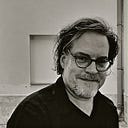Review: Hopkinson Smith’s Bittersweet Science of the Lute

By Bradley Bambarger <2005>
Once upon a time, when the world was much quieter, the lute was the premier, princely instrumental voice — intimate, complex and expressive, ideal for accompanying songs and dances or for playing solo. Not long after Bach and Vivaldi’s day, though, the lute was overwhelmed by the noise of incipient modernity.
Playing the lute today requires the soul of a poet and the curiosity of a scientist. It seemed apt that Hopkinson Smith, one of the world’s rare masters of the lute, would perform at Fine Hall’s Taplin Auditorium on the Princeton University Campus. Walking the Fine corridors at intermission on Wednesday evening, one could see blackboards filled with the equations of higher mathematics, as Greek to most people as the antique manuscripts Smith pores through for his repertoire.
Cultured and confident in his way but shyly soft-spoken, the 58-year-old Smith seems every inch the poet-scientist. The New York-born, Harvard-trained sage of many archaic plucked instruments now resides in Switzerland, where he teaches at Basel’s Schola Cantorum, a hallowed academy for early music. Smith’s more than 20 solo recordings — of Milan, Gallot, Weiss, Bach — are like an illuminated manuscript in sound, articulating a whole world of ancient scores, abstruse techniques and deep, timeless emotions.
Smith’s recital last year at Taplin featured the works of iconic Elizabethan composer-lutenist John Dowland (the subject of his latest Naïve recording). Smith debuted a new, old program on Wednesday, playing the Renaissance lute — smaller and simpler than the instrument’s Baroque version — in French and Italian music of the 15th and 16th centuries. Through eyeglasses sliding down his nose, Smith peered at sheet music laid across a low table covered by the green-and-gold scarf that he uses to swaddle his instrument in its case. The sight was unassuming and personable, yet the sound was magical and transporting.
In one of his courtly spoken preludes to the various sections of the program, Smith described the Fantasias of Francesco da Milano as “extremely humbling to play — the counterpoint seems to go almost beyond the instrument.” Lonely melodies drifted out of the piquant harmony as he played, with the occasional broken note or blurred passage underlining not only Smith’s preface but the vulnerable, very human qualities of the lute (and its players). He juxtaposed Francesco’s erudition with the earthy dance tunes of Pietro Paolo Borrono. His “Saltarello: Il Pescatore che va Cantando” featured a drone with an open bass note, hinting at the grooves of more contemporary times.
Prior to playing pieces by Albert de Rippe, Smith called him one of the strangest composers of the Renaissance, “a polyphonic wanderer.” He said, “Playing some of his music is like entering a forest, getting lost, then coming out in some place you recognize. But you don’t know how you got there.” Taplin’s cozy seating and dry but clear acoustics allowed listeners to follow Smith closely as he traced his deft way through De Rippe’s harmonic maze.
Pierre Attaingnant was a Parisian music publisher whose early lute books featured preludes, chansons and dances by many anonymous authors. Rooted in an old folk dance often accompanied by bagpipes, the Attaingnant “Haulberroys” was intoxicating; the beguiling tune cycled around and around, with the different voicings spurred by Smith’s shifting fretboard hand evoking a dancer taking a different partner with every turn. Like many of these tunes so big on the Renaissance hit parade, what was once upbeat now sounds melancholy.
Boxing fans call their sport “the sweet science.” Perhaps Smith’s art, allusive of something virtually forgotten yet strangely resonant, should be termed the bittersweet science.
(Originally published on April 16, 2005, in The Star-Ledger of New Jersey.)
